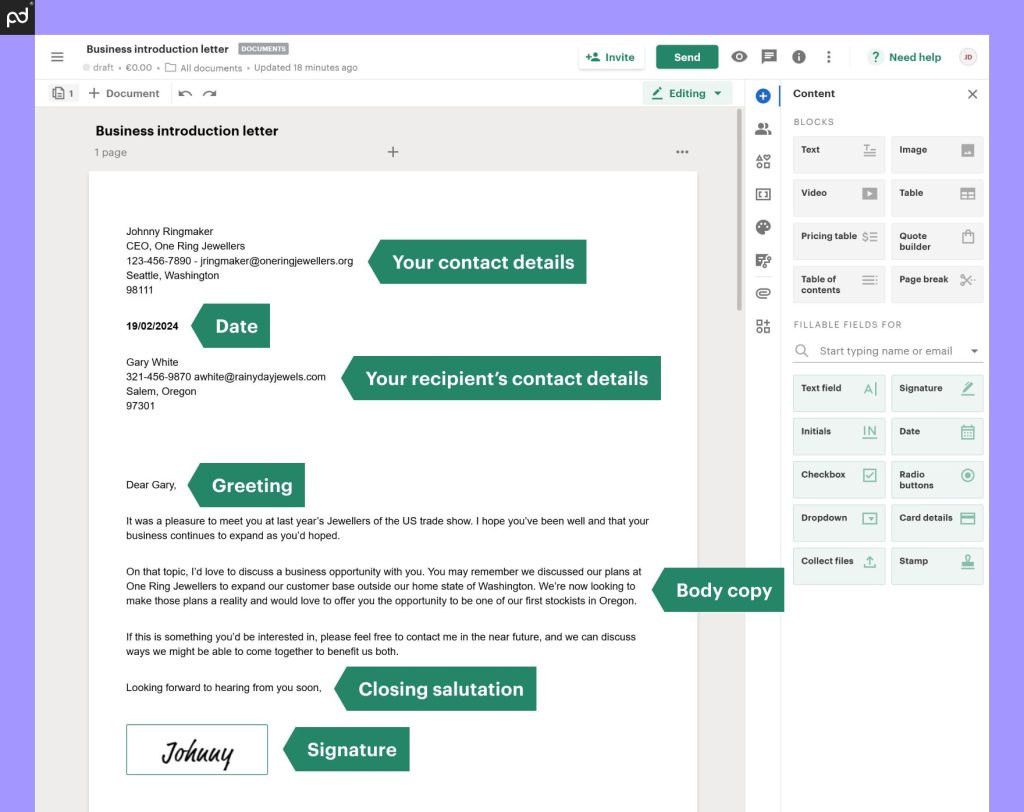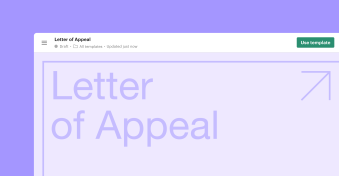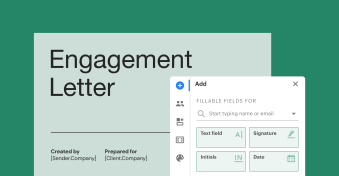A business introduction letter is a fantastic way to show off your company to potential business partners, suppliers, investors, and customers.
If you’ve always wanted to know how to write one, you’ve come to the right place.
We’re going to look at what makes a good business introduction letter and why they’re important before taking a look at some templates and examples to show you exactly what we’re talking about.
Key takeaways
- A business introduction letter helps you to make a good first impression, builds credibility for your brand, and helps you to show off your goods and services.
- Business introduction letters can vary depending on whether you’re sending them to another business or a potential customer.
- The most effective business introduction letters are personalized, easy to read, and short but sweet.
- Document generation software can help you draft top-notch business introduction letters in no time, with minimum hassle.
What is a business introduction letter
A business introduction letter, sometimes known as a company introduction letter or corporate introduction letter, is pretty much exactly what you’d think: it’s a letter you send to introduce somebody to your business.
They’re a crucial first step in a business relationship, and you should consider using them before you start drafting a business proposal.
Business introduction letters are usually quite formal, although that’s not set in stone.
If your brand identity is quite relaxed and informal, your business introduction letters will probably reflect that.
They can be as long or short as you need them to be, but there are a few key features that you’ll always want to try and include in there somewhere.
These can include:
- A bit of history about your business, e.g. when you started, where you’re based, and any success you’ve had recently.
- A broad overview of your business goals and mission so your recipient knows they align with theirs.
- How you think the recipient could benefit from your services/a partnership with you.
- An invitation to a further meeting, on the phone, over video chat, or face-to-face.
- A brochure showing off the goods/services you offer in more detail.
Business-to-business vs. business-to-customer
Business introduction letters usually fall into one of two categories: business-to-business or business-to-customer.
A business-to-business introduction letter is sent by one business to another.
This might be to offer a potential partnership, discuss investment opportunities, or advertise products or services if other businesses are their target customer.
A business-to-customer introduction letter is sent by a business to a potential customer.
This could be to introduce them to their products and services, inform them of a sale or other special discount event, or inform them about the launch of a new product.
Why is a business introduction letter important
In the age of instant messaging, a business introduction letter might seem like an outdated concept.
They’re still incredibly important, however, and crafting one is a worthwhile investment of time, especially for new businesses.
A business introduction letter provides a professional, often formal, method of initial contact.
It’s a great way to build a rapport with potential partners or clients, and provides a space to create awareness and build trust in your brand.
7 benefits of business introduction letters
There are many potential benefits to using business introduction letters:
- Makes a good first impression – A business introduction letter allows you to control the way others see your business right from the first time they hear about it.
- Forges strong relationships – They lay the groundwork for future communication, ensuring that the recipient has all your contact details should they ever need to get in touch.
- Builds credibility – Letters introducing business provide a great opportunity to show off a bit, highlighting your achievements and establishing you as an expert in your field.
- Demonstrates your values – They’re also a great place to display your values and goals, showing potential clients and partners how they can align with their own.
- Provides a personal touch – A business introduction letter can be easily personalized to speak directly to the recipient, helping you to instantly build a rapport and forge a strong relationship.
- Clear communication – Much less ambiguous than an instant message or Facebook ad, a business introduction letter gives you the room to communicate your message and make sure you’re understood.
- Shows off what you’re selling – They’re the perfect place to highlight the unique selling points of your products and services that will make them irresistible to potential customers or a great opportunity for investors.
How to write a business introduction letter in 9 easy steps
If you’re finding the thought of writing a business introduction letter quite daunting, don’t worry; you’re not alone.
We know how important it is to get your business introduction letters right, so we’ve put together this handy guide to help you through the process.
1. Determine your purpose
Before you type even one character for your business introduction letter, you need to have a clear idea of what you’re trying to say.
The intent of your letter will inform everything from its style to its content.
For example, if you’re writing a business-to-customer introduction letter, you might write in a more informal way than for a business-to-business introduction letter.
2. Research, research, research
Once you’ve got a general idea about what your letter is going to say, you need to make sure you’re saying it with some authority.
Other businesses in your field will know what they’re talking about and will be able to spot somebody who doesn’t from a mile away.
If you’re writing to other businesses, ensure you’ve thoroughly researched their brand, including their placement in the industry, their goals and values, and the products and services they offer.
If you’re writing to customers, research other popular products and services comparable to your own for a better idea of how to set yours apart as a market leader.
3. Identify a need
This comes as a direct result of your research.
Once you’ve identified the needs of your recipients, you can tailor your letter to make sure it positions you as the perfect solution to their problems.
Personalize your letters for each recipient, making sure they focus on information relevant to their specific needs.
4. Start with a strong opening
You need to make sure you capture your reader’s attention from the first line.
A good opening will encourage them to read on and will make your letter stand out amongst the other letters they’re receiving from similar companies.
A slogan or memorable quote can be a good way to begin, providing it’s directly relevant to the rest of your letter and aligns perfectly with your brand identity.
5. Keep it simple
While you want to include as much relevant information as possible in your letter, you must also be wary about making it too long.
A three-page letter filled with facts and figures might seem like the perfect way to back up your case, but it can be a daunting read for your recipient and might make them skip over it entirely.
Think of your business introductory letter as an executive summary at the start of a business plan.
Rather than going into lots of detail, you’re giving the reader a taste of what’s to come.
6. Include a call to action
A call to action at the end of your letter clarifies what you want your reader to do and gives them a next step to follow.
This might be visiting your website, contacting you for more information, or making a first purchase.
7. Finish it off perfectly
Make sure you include a proper closing to your letter after a call to action. This helps the whole thing feel more personable and less ‘salesy’.
Formal business-to-business letters usually finish with ‘yours truly’ or ‘sincerely.’
Informal letters, on the other hand, might use ‘best wishes’ or ‘warmest regards’ instead.
8. Proofread
Once you’ve finished your letter, make sure you check it over for spelling mistakes and grammatical errors.
Sending out a letter filled with these could have the opposite effect you were hoping for, making you seem unprofessional and sloppy.
9. Send it
Once you’re satisfied that your letter looks perfect, it’s time to send it out.
Make sure the mailing address is correct and the right letter goes in the right envelope if you’re sending out a batch of letters all at once.
Top tips for writing a business letter of introduction
Read our step-by-step guide to writing a business letter of introduction but still want to know more?
That’s good, it shows you’re serious about getting this crucial correspondence correct.
Here are some more top tips for you to sink your teeth into.
Personalize
Make sure each letter is directly relevant to its recipient and contains unique information they’ll appreciate.
This helps you form a stronger connection with your reader and shows you’ve done your research.
Watch your language
Many technical jargon and industry terms might impress other businesses in your industry, but they’ll likely be lost on the everyday consumer.
Use language that will appeal to your reader, and if you do use some insider phrases or acronyms, make sure they’re explained clearly.
Follow up
Company introduction letters should be the start of a conversation.
If it’s been a while and you haven’t heard back from your recipient, consider sending a polite follow-up letter to show your continuing interest.
Business introduction letter format
By now, you should have a good idea of what kind of content to include in your business introduction letter.
But what about how to set it all out? Don’t worry, we’ve got you covered there, too.
A strong corporate introduction letter will usually include the following sections.

Your contact details
The top-left corner of your business introduction letter should display your contact details.
This should include your full name, your position in the company, a contact phone number and email address, and the full address of the business.
Including these details is crucial so that the recipient knows where and how to contact you when they want to respond.
The date
Leave a space under your contact details, then include the date you’re writing the letter.
Your recipient’s contact details
Leave another space, then add the recipient’s contact details in the same format that you listed your own.
Greeting
Leave a space, then on a new line, you can begin your letter.
The first step is a greeting or opening salutation.
If you know the recipient, you can use ‘Dear [first name]’.
If you don’t, it’s better to start with ‘Dear Mr/Mrs/Ms [Last Name].’ I
f, for some reason, you can’t find a specific contact to address your letter to, you can always use ‘To whom it may concern.’
Body copy
Leave another space and start a new line before beginning the main bulk of your letter.
This is where you’ll express the main reason for your letter, along with any information you’ve gathered that backs up your proposal.
Generally, you should try to keep it to three or four paragraphs maximum.
The first paragraph should be your opening section, followed by a couple of paragraphs that cover your main argument, finished off by a closing paragraph.
Closing salutation
Another space, another new line, then you can include your signing-off statement or closing salutation.
Popular examples include ‘Cordially,’ ‘Yours sincerely,’ ‘Respectfully,’ and ‘Thank you for your time.’
Signature
Add a space where you can sign your name. You can do this by hand or using eSignature software.
Print your full name on the line underneath.
Formatting
Finally, there are just a few pointers to remember regarding the general formatting of your letter:
- Use a professional font that’s easy to read, such as Arial or Times New Roman.
- Most business introduction letters will be written in a font size between 10 and 12.
- Remember to include spaces between each section and start a new line for each new section.
- Use single spacing for the body paragraphs of your letter to keep things looking clean and readable.
- Business letters use margins that are slightly larger than usual, up to one and a quarter inches.
Business introduction letter templates
Looking for a business letter template for your introductory communications?
Look no further!
Business-to-business introduction letter template
[Your first name] [Last name], [Degree or certification, if applicable]
[Company Position]
[Phone number] [Email address]
[City], [State]
[Zip code]
[Date]
[Recipient’s first name] [Last name], [Degree or certification if applicable]
[Company Position]
[Phone number] [Email address]
[City], [State]
[Zip code]
Dear Mr/Mrs/Ms [Recipient’s Last Name],
[Introductory paragraph]
[Explanatory paragraph]
[Closing paragraph]
Sincerely,
[Signature]
[Full name Last name]
Business-to-customer introduction letter template
[Your first name] [Last name], [Degree or certification, if applicable]
[Company position]
[Phone number] [Email address]
[City], [State]
[Zip code]
[Date]
[Recipient’s first name] [Last name]
[Phone number] [Email address]
[City], [State]
[Zip code]
Dear [Recipient’s Full Name],
[Introductory paragraph]
[Explanatory paragraph]
[Closing paragraph]
Looking forward to hearing from you soon,
[Signature]
[Full name Last name]
Business introduction letter samples
If you’re looking for a sample of the kind of language or phrases you could include in your business introduction letters, we’ve all you need there, too.
Sample business-to-business introduction letter
Johnny Ringmaker
CEO, One Ring Jewellers
123-456-7890 – jringmaker@oneringjewellers.org
Seattle, Washington
98111
19/02/2024
Fred Bagman
CEO, Swift Suppliers LTD.
987-654-3210 – fbagman@swiftsuppliers.com
Seattle, Washington
98105
Dear Mr Bagman,
As CEO of One Ring Jewellers, I’m writing to you with what I hope will be an interesting business proposition.
First, I hope you’ll indulge me in sharing some background information about our business. Established in 1902, we at One Ring Jewellers have been creating luxury jewelry for the people of Seattle for over 100 years. We have a dedicated customer base who eagerly await our latest collections and are well-known in the local area for creating high-quality, eye-catching pieces.
After many years of serving the people of Washington, we think it’s time to expand our operations and deliver our fine jewelry far and wide. We understand that as the premier jewelry distributors in the greater Seattle area, you’ve no shortage of experience in endeavors such as these.
We hope you’ll agree that our two businesses are ideally placed to partner together, and we’d love to discuss making this dream a reality. If you’re interested, please get in touch at your earliest convenience for a more in-depth discussion of what this partnership could look like.
Sincerely,
Johnny Ringmaker
Business-to-customer introduction letter sample
Johnny Ringmaker
CEO, One Ring Jewellers
123-456-7890 – jringmaker@oneringjewellers.org
Seattle, Washington
98111
19/02/2024
Gary White
321-456-9870 awhite@rainydayjewels.com
Salem, Oregon
97301
Dear Gary,
It was a pleasure to meet you at last year’s Jewellers of the US trade show. I hope you’ve been well and that your business continues to expand as you’d hoped.
On that topic, I’d love to discuss a business opportunity with you. You may remember we discussed our plans at One Ring Jewellers to expand our customer base outside our home state of Washington. We’re now looking to make those plans a reality and would love to offer you the opportunity to be one of our first stockists in Oregon.
If this is something you’d be interested in, please feel free to contact me in the near future, and we can discuss ways we might be able to come together to benefit us both.
Looking forward to hearing from you soon,
Johnny
Create, send, and manage documents and letters with robust document generation software
Business introduction letters are a great way to spread the word about your business, helping you to forge strong partnerships and attract new customers.
Document generation software can help you craft professional, eye-catching documents, including company introduction letters.
PandaDoc’s document generation software is packed with a wide range of business document templates you can fully customize to create letters that perfectly represent your brand.
Not only that, but integrations with a wide range of CRM platforms and project management tools allow you to quickly and easily populate your letters with all the relevant information you need, saving you time and effort that you can instead dedicate to your business.
Frequently asked questions
-
You should send a business introduction letter when launching a new business or entering a new market. It’s a great way to introduce yourself to potential clients, partners, and suppliers.
You can also send one when you launch a new product or service, or to reach out to new prospective customers.
-
Yes, ideally you should personalize your letters of introduction for business wherever possible. Personalization helps to make your letters relevant to their recipients, keeping them engaged and building stronger relationships as a result.
-
You should keep local privacy laws in mind when drafting business introduction letters, as these govern how you collect and use personal data. It’s also a good idea to check compliance with anti-spam laws if you’re considering sending business introduction emails.
Disclaimer
PandaDoc is not a law firm, or a substitute for an attorney or law firm. This page is not intended to and does not provide legal advice. Should you have legal questions on the validity of e-signatures or digital signatures and the enforceability thereof, please consult with an attorney or law firm. Use of PandaDoc services are governed by our Terms of Use and Privacy Policy.


